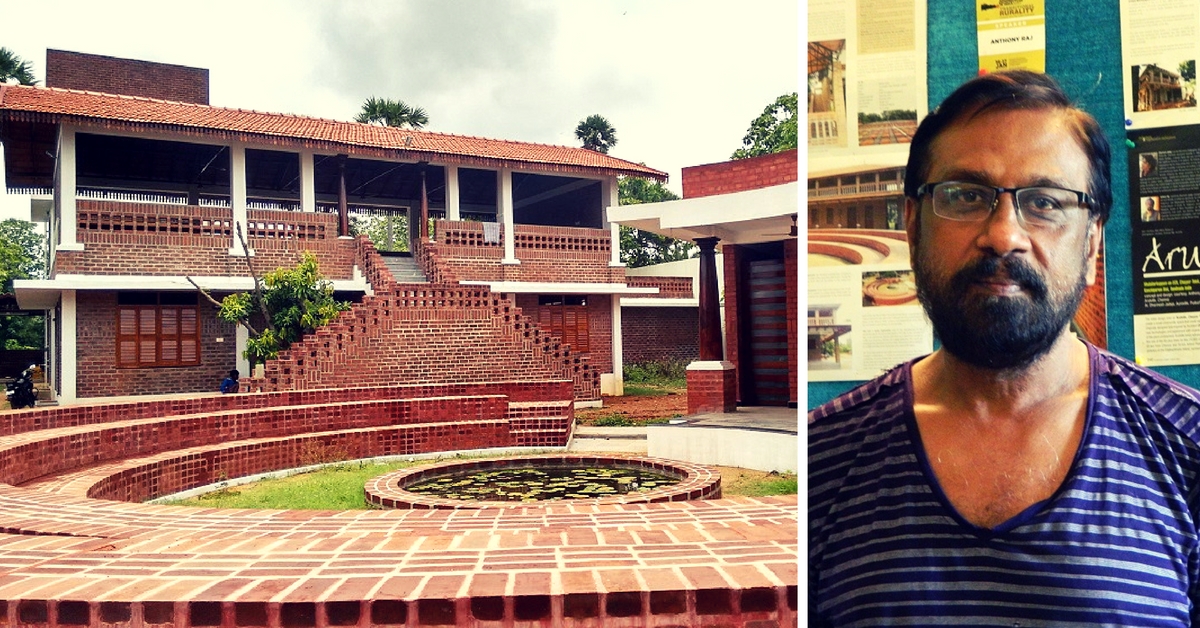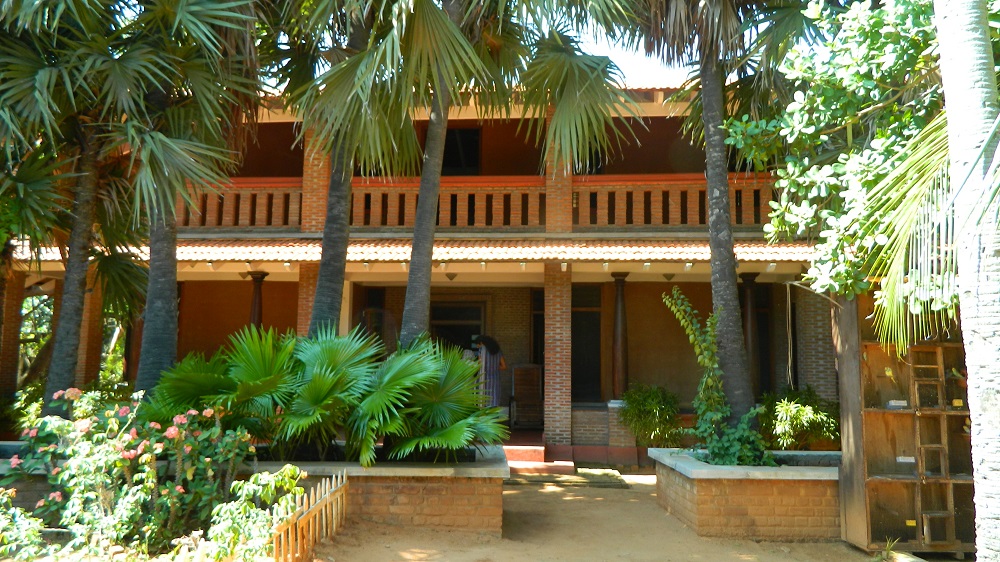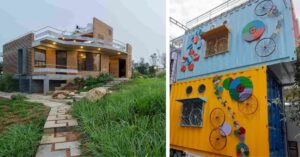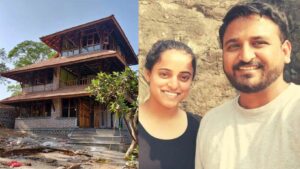This Man Quit the Corporate World to Embrace Indigenous Architecture and Build Eco-Friendly Homes
Anthony Raj worked in the corporate sector for several years before he learnt about indigenous architecture techniques and became fascinated by them. Today, he builds many eco-friendly homes in India. This is his story.

Anthony Raj worked in the corporate sector for several years before he learnt about indigenous architecture techniques and became fascinated by them. Today, he builds many eco-friendly homes in India. This is his story.
“My family wanted to invest in a farmhouse on the outskirts of Chennai, back in 2010. Our search led me to Mudaliarkuppam in Edaikazhinadu, about 80 km from the city. We were thrilled to see the huge banyan trees and the abundance of coconut, cashew, and palmyra trees there. The greenery in the area motivated us to build something that would be in sync with this beautiful land. So we came up with the idea of constructing a house using eco-friendly material, utilising indigenous architecture techniques,” says Anthony Raj, the founder-director of the Centre for Indigenous Architecture, which promotes wellness by constructing buildings using holistic architectural methods.
Anthony, who left the corporate world behind a few years ago, is currently involved in building organic habitats across the country, using an indigenous architectural approach.

He started this journey with the construction of a farmhouse on his family’s land – a house that is now known as Arulville and is considered to be a model for sustainable architecture.
Indigenous architecture is based on local needs and availability of construction materials. It reflects the local traditions and is about the beauty and benefits of native architecture. The technique involves minimal use of cement, steel, paint, etc. The use of electricity for cooling is also minimised.
Locally available materials are used for eco-friendly, energy-efficient, cost-effective and sustainable construction.

The 61-year-old was inspired to take up this form of construction by Dr. Satyaprakash Varanasi, a former professor of architecture living in Bengaluru, who has been promoting eco-friendly, cost-effective architecture for years now. He wrote to Dr. Varanasi, requesting his help in building his dream house; Dr. Varanasi then introduced him to Dharmeshbhai Jadeja, an architect from Auroville.
“While Dharmeshbhai could not spare much time for us, he helped with the initial design of the farmhouse and gave it the look of a mini resort. He also gave me deep insights into the concept of indigenous architecture. That is how and when I was bitten by the indigenous architecture bug, its beauty, and its benefits. Soon, I designed the campus of the farmhouse with whatever little knowledge I had and with the help of contractors and artisans from Auroville,” he says.
Anthony used several techniques, using different indigenous materials. The construction team did not cut a single tree on the site; instead, the family has added 40 more trees over the years.

Today, Arulville serves as a ‘model house’, an eco-tourism destination, and as an inspiration for many students and teachers of architecture. The construction has been documented by several architecture students. It also serves as a mini exhibition of sorts for the demonstration of the various materials and techniques used in indigenous architecture.
“Arulville brought me a lot of appreciation and encouragement. Many have visited us here. Some had the fortune to stay and enjoy the environment it is enveloped in,” says Anthony.
Madly in love with this kind of architecture, which enhances health and happiness, Anthony decided he wanted to spread the concept as much as he could.

This is when he quit his job as the Executive Director of Shriram Group and set up the Centre For Indigenous Architecture (CFIA).
CFIA takes up one project at a time. This helps Anthony’s team members fully immerse themselves in every aspect of design and construction. Anthony’s second project, right after the farmhouse, was a centre called Vedapatashala where Vedic scholars teach and discuss Vedic practices.
Since then, the team has built an ashram campus, constructed right in the middle of a granite quarry, and a small bungalow located on a sandy beachfront. They are currently working on a home for senior citizens in Chennai, where they are trying to reduce the noise level and fight industrial heat and dust because the home is coming up in the heart of an industrial estate.

“All my buildings are designed to provide physical and visual comfort through proper ventilation, rather than depending on heating, ventilation and air conditioning (HVAC),” says Anthony.

Some of the traditional cooling techniques employed in tropical climatic zones include Madras terrace, rammed earth walls, sloped clay tiled roofs, etc. Such constructions are highly resistant to radiation and help in conduction of heat to bring thermal comfort to the occupants despite the heat and humidity. Additionally, most of these buildings have verandahs as buffer spaces that protect the external walls from direct sunlight. Shading the external walls up to 50% from the sun is necessary for those living in hot and humid climates.
Anthony says the discovery of this construction method was an inward journey for him. “I did not travel much for research except for a few visits to Auroville. Coming from Nagercoil in Tamil Nadu, I had seen traditional style dwellings when I was young. I had also seen many such houses in Kerala, erstwhile Bombay, and Bangalore. This is why I refer to it as the ‘grandfather’s house architecture’. My work is my tribute to the innate wisdom and practicality of our ancestors. It is a salute to their practice of building climate-responsive habitats over the centuries.”
“With increasing urbanisation, and consequent changes in lifestyles and affordability, we are bidding goodbye to the more sensible, healthier habitats of yore. To reverse this trend, architects must demonstrate the beauty and benefits of indigenous architecture in urban, semi-urban and industrial contexts,” he adds.
Anthony is not a trained architect but he has never been afraid of venturing into new territory. He says architecture is his passion and full-time hobby.

“Strangely, I have never felt any fear. Not when I invested the family’s hard-earned savings in a crazy project like Arulville. Not by the fact that I am not a trained architect. In fact, this career after my voluntary retirement is a dream come true. The joy of designing for the specific needs of each client is only matched by the wonder and appreciation you see in their eyes at every stage of construction,” he says.
In the future, Anthony wants to empower young architects through the Centre For Indigenous Architecture, to study and collaborate with other architects on architectural projects, and to research different techniques and materials. His motto? “Leave the place better than you found it’,” concludes Anthony.
(Written by Rajasekar KS)
You can contact Anthony by writing to him at [email protected].
Like this story? Or have something to share? Write to us: [email protected], or connect with us on Facebook and Twitter.
NEW: Click here to get positive news on WhatsApp!
This story made me
-
97
-
121
-
89
-
167
Tell Us More
We bring stories straight from the heart of India, to inspire millions and create a wave of impact. Our positive movement is growing bigger everyday, and we would love for you to join it.
Please contribute whatever you can, every little penny helps our team in bringing you more stories that support dreams and spread hope.



















